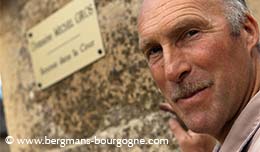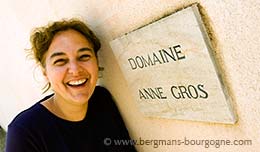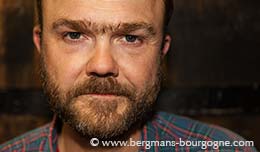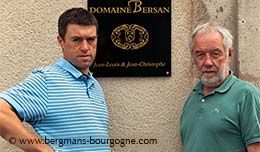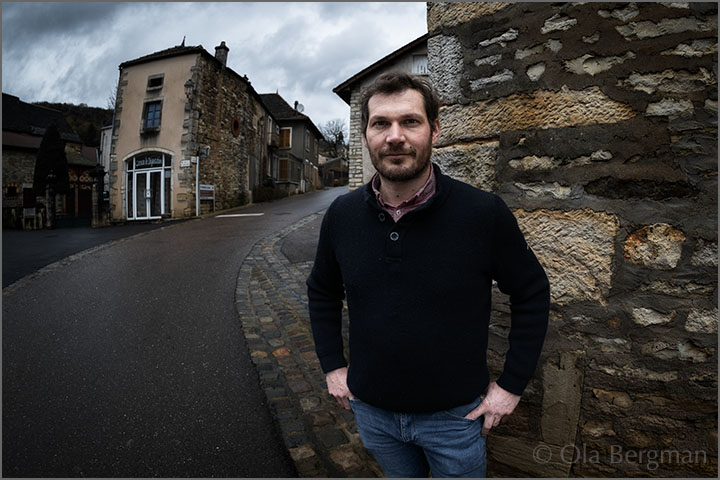
p in the Hautes-Côtes things have changed over the past two decades. A new generation of winegrowers, a different approach and climate change have turned this part of Burgundy into a very interesting area.
– For me the Hautes-Côtes is the future of Burgundy. There is still room for development, with many possibilities. We can keep up with climate change. You can keep the freshness in the wine, says Lucien Rocault at Domaine Fanny & Lucien Rocault.
The Rocault family has been around for quite some time. Since 1470 to be more precise. Lucien Rocault is the 18th generation and he is the first one to stray outside the village of Orches, at least to some extent. The cuverie is still in Orches, but the barrel cellar has moved to nearby Saint-Romain. Up until 1947 Saint-Romain was part of the Hautes-Côtes, then it received its own village appellation.
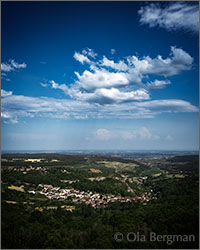 – Climate change has affected everyone, continues Lucien Rocault, but the last 20 years have seen changes in the Hautes-Côtes that few other appellations in Burgundy have. Saint-Romain has moved up quality wise. The Hautes-Côtes too, especially the ten last years. It’s a combination of refining the ways of working and climate change.
– Climate change has affected everyone, continues Lucien Rocault, but the last 20 years have seen changes in the Hautes-Côtes that few other appellations in Burgundy have. Saint-Romain has moved up quality wise. The Hautes-Côtes too, especially the ten last years. It’s a combination of refining the ways of working and climate change.
In terms of altitude the Hautes-Côtes are higher up than the Côte de Beaune and the Côte de Nuits. Previously this put the Hautes-Côtes among the cooler, hard-to-ripen appellations. Climate change has made it easier for the grapes to ripen.
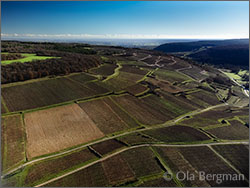 – At the moment this is an advantage for us, says Lucien Rocault. For the harvest there used to be more of a difference between when it started in the Côte de Beaune and the Hautes-Côtes. There was a gap of a week, maybe ten days, but now we just continue when we are done with our vineyards in the Côte de Beaune. My white Hautes-Côtes is even often ready for harvest before my Saint-Romain.
– At the moment this is an advantage for us, says Lucien Rocault. For the harvest there used to be more of a difference between when it started in the Côte de Beaune and the Hautes-Côtes. There was a gap of a week, maybe ten days, but now we just continue when we are done with our vineyards in the Côte de Beaune. My white Hautes-Côtes is even often ready for harvest before my Saint-Romain.
Lucien Rocault describes today’s atmosphere in the Hautes-Côtes as very dynamic. Many young growers have set up their own domaines or taken on the family domaines. In addition to that in recent years many domaines in the Côte de Beaune and the Côte de Nuits have started looking for vineyards in the Hautes-Côtes.
– The upside is that it brings focus on the appellation, says Lucien Rocault. The downside is that the vineyard prices increase, which makes it difficult for young growers or family domaines to buy vineyards.
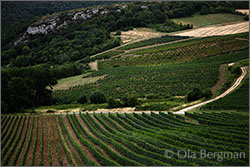 The two appellations – Bourgogne Hautes-Côtes de Beaune and Bourgogne Hautes-Côtes de Nuits – which make up the Hautes-Côtes cover 1480 hectares, but there remains a lot to be planted. More than a third is not planted.
The two appellations – Bourgogne Hautes-Côtes de Beaune and Bourgogne Hautes-Côtes de Nuits – which make up the Hautes-Côtes cover 1480 hectares, but there remains a lot to be planted. More than a third is not planted.
– I think there are parts that never will be planted, says Lucien Rocault. New ways of looking at the environment make it difficult. There are species that need to be protected. There are things of ecological interest. Places where it may not be very smart to plant. Much of the work within the appellation is to identify the parts which have the potential for the future, which doesn’t have too much of an impact on the environment. It is not a good idea to destroy the natural habitat for certain species. It’s all a matter of balance.
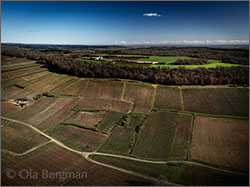 – It’s not the 1980s or the 1990s when you would show up with a mechanical digger, shave off everything and do whatever you wanted. The thinking is different today. We are part of UNESCO’s world heritage with our terroir. You can’t reshape the terroirs that already exist.
– It’s not the 1980s or the 1990s when you would show up with a mechanical digger, shave off everything and do whatever you wanted. The thinking is different today. We are part of UNESCO’s world heritage with our terroir. You can’t reshape the terroirs that already exist.
– We are unique thanks to the land. The Syndicat de Défense des Hautes-Côtes de Nuits et Hautes-Côtes de Beaune is doing a lot of work for the appellation. The main task is to redefine the parcels, maybe include some that were not previously included. They are better exposed today with climate change.
– Not everyone agrees, but I think the Bourgogne prefix in the name of the appellation should be removed. There is really an identity up here. And maybe have Hautes-Côtes Village appellation for certain parcels.
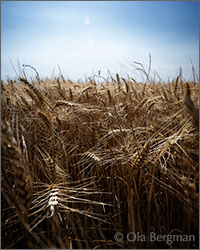 A large portion of Domaine Fanny & Lucien Rocault is Hautes-Côtes wines. Much is centered around Orches, the small village with 80 inhabitants where the Rocaults have been for centuries. The Bourgogne Aligoté comes from a small parcel in Orches called Sous le Puits. The white Bourgogne Hautes-Côtes de Beaune, La Couleuvraie, is also from Orches.
A large portion of Domaine Fanny & Lucien Rocault is Hautes-Côtes wines. Much is centered around Orches, the small village with 80 inhabitants where the Rocaults have been for centuries. The Bourgogne Aligoté comes from a small parcel in Orches called Sous le Puits. The white Bourgogne Hautes-Côtes de Beaune, La Couleuvraie, is also from Orches.
– We have always been in Orches. We have also been lucky to be able to track the family all the way back to 1470. Often archives have been destroyed in wars etc. A cousin of ours has done a lot of research. We now know who everyone was all the way back and that we always have been farmers or winegrowers in Orches.
– We have always had a mix of wine growing and cereal farming. My parents specialised in wine, whereas I have taken on cereal farming again. The origin of today’s domaine is my great-great-grandfather. Between 1850 and 1900 the domaine was prosperous. Then came the first world war and my great-grandfather went to war. My great-grandmother and her sisters-in-law took care of the vineyards. It wasn’t easy and it was at the same time as the phylloxera. It was a very complicated period.
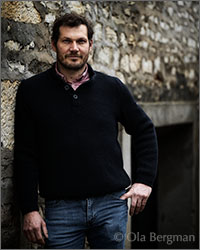 – Then for my grandfather it was very difficult, it was plain misery between the wars. He was making wine in a part of Burgundy that was unknown. The Hautes-Côtes appellation did not exist. The wine was sold as Bourgogne des Coteaux Beaunois. It at that time he decided to create a cooperative with his neighbour. La Cave des Hautes Cotes was created in Orches in 1957. It was initially called Cave du Rosé d’Orches. Back then the price of wine was nothing like it is today.
– Then for my grandfather it was very difficult, it was plain misery between the wars. He was making wine in a part of Burgundy that was unknown. The Hautes-Côtes appellation did not exist. The wine was sold as Bourgogne des Coteaux Beaunois. It at that time he decided to create a cooperative with his neighbour. La Cave des Hautes Cotes was created in Orches in 1957. It was initially called Cave du Rosé d’Orches. Back then the price of wine was nothing like it is today.
In 1961 the appellation was created. Lucien Rocault’s parents stopped the cereal farming in 1980 and focused on wine, tourism and their chambre d'hôtes. But they stayed with the coop.
– After I finished school I vinified abroad, in New Zeeland and California, and when I returned I wanted to make wine. So I started off on my own. I took on a parcel of my aunt’s. I created the domaine with that together with my wife Fanny, who is from Nuits-Saint-Georges. She said we have to go organic. We were not well-known and that is the future. I was neither against it nor for it. But let’s go, I said. The first year we had 80 ares of white Hautes-Côtes La Couleuvraie. That was all there was.
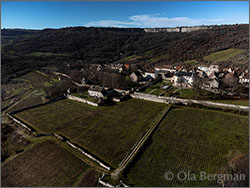 They continued and by 2022 they had accumulated eight hectares of vineyards. In early 2023 Lucien Rocault’s parents retired, which added another six hectares to the domaine. Apart from the Hautes-Côtes wines there are now both village appellation Pommard and Beaune (the smallest parcel of the domaine), as well as two Pommard premier crus – Les Combes Dessus and Les Charmots. There are two white Saint-Romain – Sous Roche and Sous le Château – and a Saint-Aubin premier cru, En Remilly.
They continued and by 2022 they had accumulated eight hectares of vineyards. In early 2023 Lucien Rocault’s parents retired, which added another six hectares to the domaine. Apart from the Hautes-Côtes wines there are now both village appellation Pommard and Beaune (the smallest parcel of the domaine), as well as two Pommard premier crus – Les Combes Dessus and Les Charmots. There are two white Saint-Romain – Sous Roche and Sous le Château – and a Saint-Aubin premier cru, En Remilly.
– The choice of profession was something obvious for me. Not really a choice. I always knew I would become farmer of some kind. Wine-growing was a bit particular since my parents sold the grapes. I never understood the vinification process. It was something that left a bit of a bitter taste, when everything stopped after the harvest. Like a cereal farmer. You sell the crop. My parents sold the grapes.
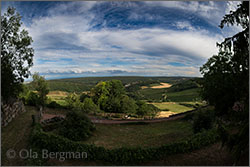 – It is so much more rewarding when you see the whole process through. When you sell your wine in a bottle. There are boring things about making wine, but when you can bring joy to people it is worth it.
– It is so much more rewarding when you see the whole process through. When you sell your wine in a bottle. There are boring things about making wine, but when you can bring joy to people it is worth it.
The vineyards of Domaine Fanny & Lucien Rocault cover 14 hectares. The cereals part is considerably larger – 150 hectares (rapeseed, wheat, barley, mustard, clover and lucerne). But in terms of time the wine takes 80 per cent of the working hours. The cereal farming has been organic since 2007 and much is delivered directly to local buyers. The barely ends up at the local brewery, while the mustard is bought by mustard producer Edmond Fallot in Beaune.
The rosé of Domaine Fanny & Lucien Rocault, nowadays labelled as a Coteaux Bourguignons, has a special story to it. Up until 1996 there was Rosé d’Orches up here.
– There has always been rosé in Orches, says Lucien Rocault. I’m not sure why, but perhaps it was because the grapes wouldn’t ripen enough. I have found notebooks from my great-grandfather. In 19222-1923 he made rosé. There was really an appellation for Rosé d’Orches, that was recognized by the INAO up until 1996.
The appellation was eventually lost. In 1996 no harvest was declared. The rosé was not a big thing in the 1990s. In Orches all growers were with the cooperative and they weren’t interested since the rosé didn’t sell. So when the system moved from AOC to AOP the appellation was lost.
– In 2010 I found a small parcel of gamay in Orches, says Lucien Rocault. A lady in the village who didn’t want to continue had ten ares. Since 2014 we are three to make rosé in Orches. It’s me, David Trousselle and one more. I am the only one to make it from gamay. The others use pinot noir. In total we are five growers in Orches. Three work with the cooperative. Not bad for a village with 80 inhabitants.
© 2025 Ola Bergman










